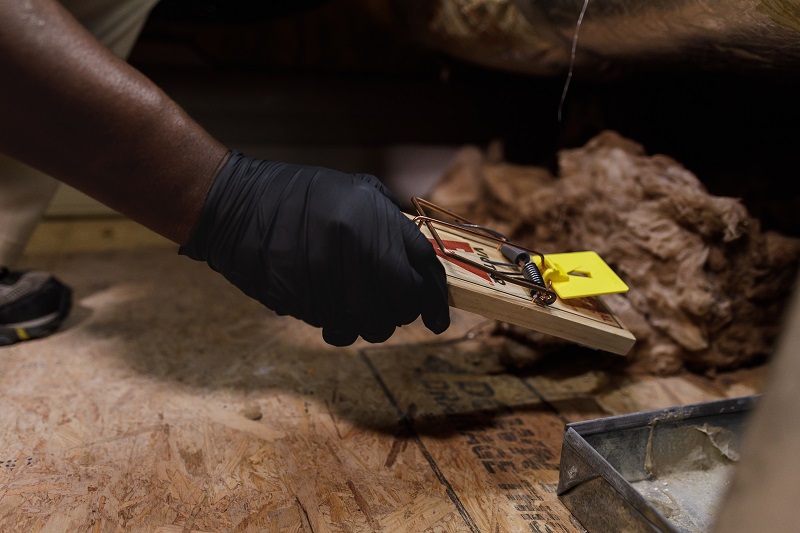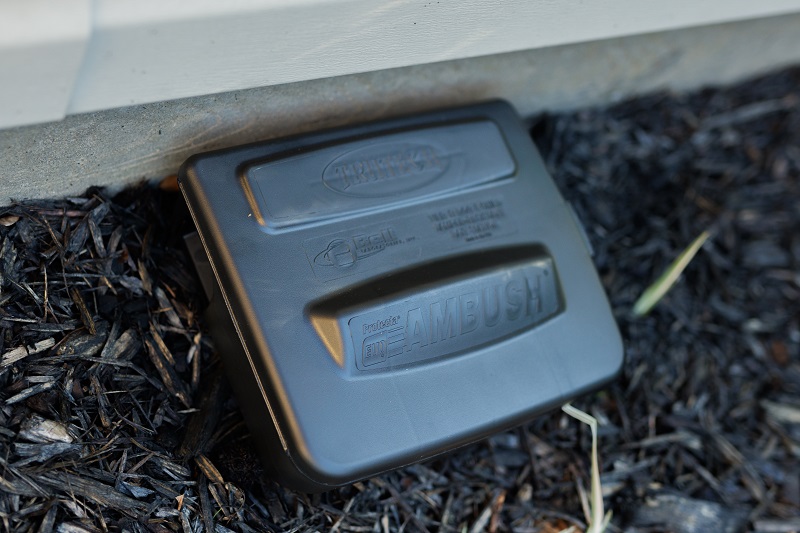Of all the critters known for infesting homes, rodents are among the most difficult to deal with. They are infamous for their resourcefulness, their intelligence, and the staggering rate at which they breed. So, to put it simply, a rodent infestation is a serious issue.
Perhaps the most popular way to deal with rats and mice is with traps. When we think of the word “mousetrap,” we probably picture one of the old-school wooden snap traps, loaded with a chunk of Swiss cheese. While these traps are still popular, rat traps are only one part of rodent control. The most effective method of rat control or mouse removal is to “build them out.”
Let’s take a look at the different types of traps for rodents, and the advantages and disadvantages of each.
Types of Rodent Traps
Snap Traps

Snap traps are as old as time. In the past, they were almost always made of wood, but some companies offer modernized versions of this age-old trap that are made of plastic and reusable. Snap traps have a small bait cup into which the bait is inserted, then you pull the metal lever back 90 degrees, and the trap is set. A mouse then steps on the plate and is a nuisance no more.
Pros
- Very affordable
- Reusable
- East to set and release
- Quick and humane
Cons
- You will need to dispose of a dead rodent
Plastic Enclosed Snap Traps
These are very similar to generic snap traps, except they are encased in a hard plastic shell, and you use a lever on the exterior of the shell to set the trap. There is also an indicator for when a mouse or is caught.
Pros
- Safer than snap traps
- Added protection for kids and pets
- Don't see a dead rodent
Cons
- One-time use
- More expensive than snap trap
Electric Traps
Electric traps work by luring rodents into a chamber and administering a lethal shock. They are gaining in popularity because they are one of the more humane options, killing mice almost instantly. They are also engineered to include a no-see, no-touch disposal procedure, and a light to indicate when a rodent has been caught. We do not recommend using these traps for large rodent infestations. You will need to replace the batteries after only a few shocks.
They are also designed to ensure that humans and pets cannot be shocked.
Pros
- Quick and humane
- Reusable
- No-see, no-touch disposal
Cons
- More expensive
- Indoor use only
- Must be keep dry
- Constantly replacing batteries
Glue Traps
Glue traps (glueboards) are very simple. They are thick industrial cards, covered in sticky adhesive. The mouse attempts to cross it and is then caught up on the sticky surface. The mouse dies due to a lack of water and food. Then the card is thrown away.
We do not recommend glue traps. They are better at catching mice than rats. Temperature extremes and dusty areas can make them less effective. Most importantly, they are not an ethical rodent control method.
Pros
- Affordable
- Can catch several rodents at once
Cons
- Least humane trap
- Potential to catch non-target animals
- Not effective on rats
Live Catch Traps
These devices are unique in this list in that they do not kill the rodent. They simply hold it until you can release it elsewhere. There are two main versions of live catch traps: metal cages, and plastic tubes, both of which are outfitted with trigger-operated doors. Metal cage traps are preferred as they are large enough that the captured mouse or rat likely won’t get overly stressed out in the time it is detained.
Pros
- No-kill method
- Can catch several rodents at once
Cons
- Must be monitored
- Mouse or rat can re-enter house
- Need a safe, release location
Bait Stations

Although they might look like a trap, bait stations or bait boxes are not a rodent trap. Bait stations contain a solid, liquid, or paste rodenticides, and increase the effectiveness and safety of rodenticides. Bait stations have two holes one for entry and one to exit. After the rodents eat the bait, they leave it. Rodenticides should be used a supplemental control option. If you need to use repeated use of baits, trapping and exclusions services are needed.
Pros
- Keep non-target animals, pets, kids away form poison
- Safe and effective to use inside or outside
- Prevents spilling bait
- Targeted placement
Cons
- Rodents do not stay in bait box
- Potential for rodentcide to spread to predators
DIY Rodent Removal
While the above traps can be very effective at controlling a rodent population, traps alone are often not enough to fully eliminate a rodent problem in your home. Traps must be used absolutely correctly and in significant numbers to even make a dent in a rodent population. Rodents, noted for their intelligence, can easily become wary of traps and learn to avoid them.
Rats and mice squeeze through tiny holes. Cracks and openings in foundations and openings for water pipes, vents, and utilities are prime locations for rodents to get into your house. Rodents can gnaw through almost anything. Plastic sheeting or screen, wood, rubber, or other gnawable materials are unsuitable for plugging holes used by mice and rats. Steel wool mixed with caulking can provide a good plug. Concrete or metal might be necessary on larger holes.
Additionally, mice and rats are not known for their hygiene, being known transmitters of such diseases as Hantavirus and Salmonella. Once the rodent population is under control, you need to sanitize and disinfect any areas populated by rodents
Professional Rodent Removal
If the rodent population in your home has gained any sort of traction, it will need to be addressed by professionals. At Trutech Wildlife, our team of experts has the necessary equipment and experience to deal with rodents en masse, so you can get back to enjoying your home.
Rodent problem? Let us take care of it


